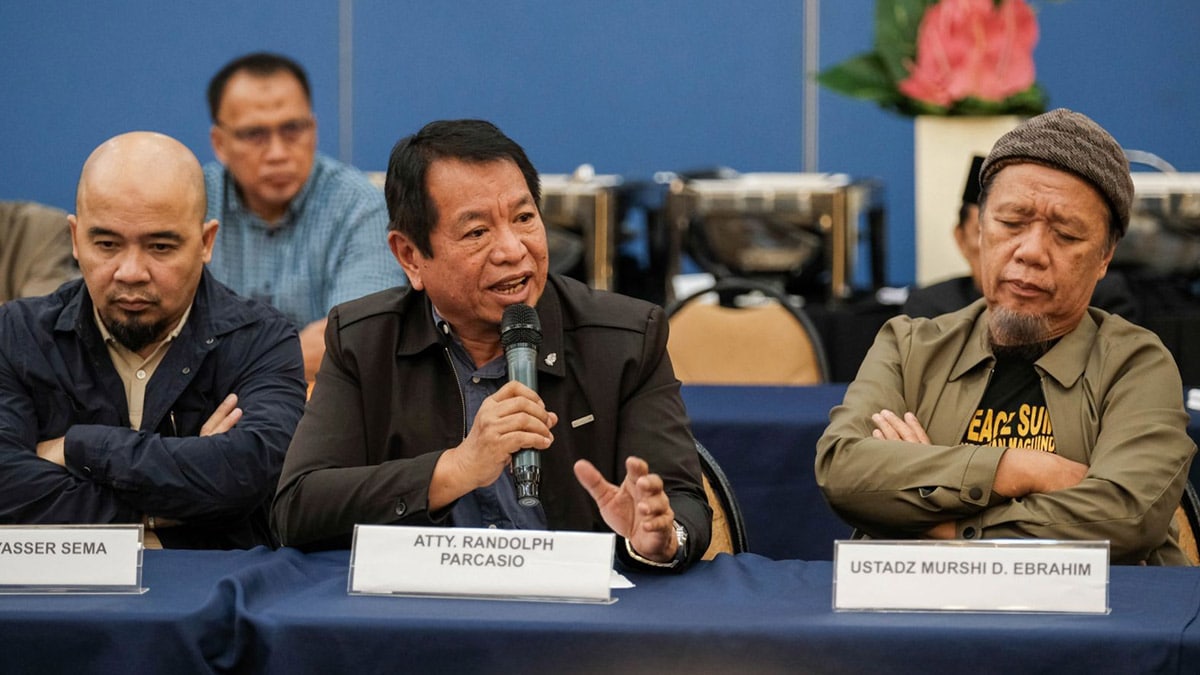Gov’t, MNLF push for ‘transformation’ of ex-rebels, war-torn villages

COMING TOGETHER From left, Bangsamoro Parliament Deputy Speaker Omar Yasser Sema, Parliament Member Randolph Parcasio, and Ustadz Murshi Ebrahim, who represent factions of the Moro National Liberation Front, join a top-level meeting hosted by the Office of the Presidential Adviser on Peace, Reconciliation and Unity (Opapru) on Aug. 13 in Davao City to push for a transformation roadmap for their respective members. —Opapru photo
ILIGAN CITY, Philippines — The government and the Moro National Liberation Front (MNLF) vowed to step up their cooperation to hasten the transformation of former fighters and their war-torn communities as they observed the 28th year after forging a peace deal.
In a historic ceremony at the Ceremonial Hall in Malacañang on Sept. 2, 1996, MNLF founding chair Nur Misuari signed with Ambassador Manuel Yan Sr. the Final Peace Agreement (FPA) that put flesh and bones to the Tripoli Agreement on Peace of 1976 firmed up between the parties under the auspices of Libyan leader Moammar Gadhafi.
Signing for the Organization of Islamic Conference (now Organization of Islamic Cooperation or OIC) Ministerial Committee of the Six were then Indonesian Foreign Minister Ali Alatas and Hamid Algabid, then secretary general. Indonesia brokered the deal through a mandate from the OIC.
READ: After 20-year split, MNLF factions unite for peace
Then President Fidel Ramos led government officials and the diplomatic community in witnessing the historic rites.
“The agreement symbolizes our ongoing commitment to peace, collaboration, and unity in bringing true and lasting peace and development to the Bangsamoro, Mindanao, and the entire country,” Presidential Peace Adviser Carlito Galvez Jr. said in a statement on Sunday.
Peace bell
Galvez on Sunday also led the opening of the National Peace Consciousness Month through the ringing of the peace bell at Quezon Memorial Circle in Quezon City.
Galvez emphasized that the full implementation of the FPA is a big part of the overall effort to achieve peace in the Bangsamoro region.
He noted that while the implementation of the agreement faced various challenges, there were also “many valuable lessons and significant gains” that showed the parties’ “unrelenting desire” to move on from the ashes of conflict.
Galvez pointed to the strong cooperation between the two main MNLF factions for development initiatives for their former fighters and their communities. Two weeks ago, leaders of the factions led by Misuari and Bangsamoro Labor Minister Muslimin Sema met with Galvez in Davao City to affirm their cooperation.
Under the FPA, some 5,750 MNLF fighters were integrated into the Armed Forces of the Philippines, in the process handing their weapons to the government.
Transformation program
To cover those who were not included in the program, the Office of the Presidential Adviser on Peace, Reconciliation and Unity (Opapru) launched the MNLF Transformation Program (MTP) last year, in an effort that resembles the decommissioning process for former fighters of the Moro Islamic Liberation Front.
Those who avail of MTP will be granted transitional cash assistance of P45,000 and will have to be profiled so their needs can be matched with existing programs.
The transformation road map, according to Galvez, is based on the FPA’s socioeconomic provision. Apart from the outright cash, MNLF combatants will also be given health insurance coverage through Philhealth, facilitated for civil registration, as well as special assistance for those who have disabilities.
The latest batch to enlist for the MTP were 161 from Lanao del Sur on Aug. 22, bringing to 1,963 the former MNLF combatants who availed themselves of the program, which also has security, confidence building and community healing and reconciliation components.
Last July, 97 MNLF members underwent the socioeconomic assessment process in Lamitan City, Basilan, while 1,705 enlisted from various MNLF stronghold communities in Mindanao last year. —Ryan Rosauro